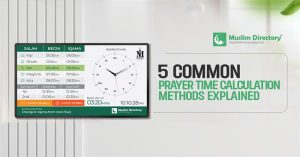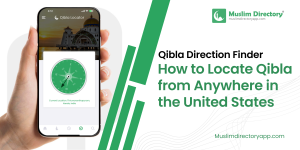“It’s Saturday night. One masjid says Eid is Sunday. Another says Monday. My kids are asking, ‘When Is Eid, for real?’ And once again, Muslims across North America are left confused, divided, and frustrated.”
Sound familiar?
As we close out Ramadan 1446, the debate resurfaces once again: When is Eid? Who decides? Why can’t we agree?
This isn’t just a calendar issue—it’s a reflection of how we, as a community, engage with the Qur’an, the Sunnah, science, and each other.
Let’s break it down—with facts, faith, and foresight.
Why the Moon Matters: The Science of March 29, 2025
According to astronomers, the new moon for Shawwal 1446 is born on Saturday, March 29 at 10:57 UTC.
But in Islam, we don’t follow the moon’s birth—we follow its sighting.
Visual Evidence: Crescent Moon Visibility Maps
Map 1 – Saturday, March 29, 2025:
Most of the world, including North America, Europe, the Middle East, and Asia, falls in the gray and red zones—meaning the moon will be invisible to the naked eye. Only parts of the eastern Pacific and western South America may see the moon under perfect conditions or with optical aid.
Map 2 – Sunday, March 30, 2025:
The moon becomes easily visible (green zone) across the entire Muslim world, including North America, the Middle East, Europe, and Africa—making this the true and verifiable evening for Eid to be declared.
These maps are developed by OmegaHilal Sighting, based on the criterion of renowned astronomer Syed Khalid Shaukat, and hosted at moonsighting.com. They are trusted by scholars, observatories, and moon committees worldwide.
Bottom line:
As per both Islamic rulings and scientific data, there will be no reliable moonsighting on Saturday night.

ISNA & FCNA: Pre-Calculated Eid Declared
Despite the clear visibility challenge, ISNA and FCNA have already declared Eid for Sunday, March 30.
Why? Because they follow a calculation-based calendar, not actual physical moonsighting. Their goal is predictability and unity—but their method contradicts the Sunnah.
The Prophet Muhammad ﷺ said:
“Fast when you see it, and break your fast when you see it. If it is cloudy, then complete the month of thirty.”(Bukhari, Muslim)
This is not metaphorical—it’s literal. The sighting is an act of ‘ibadah, not just a technicality.
Did You Know?
Since adopting the calculation method in 2006, ISNA’s decisions have often conflicted with both local moonsighting and scientific visibility data, leading to multiple Eids in cities across North America
Saudi Arabia’s Declarations: Premature and Problematic
Each year, Saudi Arabia declares Eid early, often before the moon is even visible anywhere on Earth.
This year will likely follow the same pattern: Eid on Sunday, despite scientific data showing no crescent visibility at that time.
Yet many communities in the West follow this announcement—without verification.
But let’s be clear:
Saudi Arabia is not a global moonsighting authority. There is no Islamic obligation—fiqhi or otherwise—for Muslims in North America to follow their announcements.
AMJA: “Global Moonsighting” or Saudi Sighting?
The Assembly of Muslim Jurists of America (AMJA) is a respected scholarly body. Many imams and communities look to their guidance on fiqh matters, including moonsighting.
AMJA states they follow global moonsighting, where any valid sighting in the Muslim world is enough to begin the new month.
But in practice?
The Reality:
AMJA almost always follows Saudi Arabia’s declarations, even when visibility data contradicts those claims.
They rely on:
- Unverified Saudi reports
- No independent confirmation
- No assessment of astronomical visibility
So while AMJA’s position sounds broad, it often becomes default alignment with Saudi declarations, regardless of moon visibility or location.
Fact Check:
In past years (e.g., 2011, 2015, 2020), AMJA endorsed Eid dates based on Saudi announcements—even when global visibility was scientifically impossible.
If a sighting isn’t possible anywhere in the world, yet Eid is declared—can we still call that valid?
The Sunnah Model: Local Sighting, Verified Testimony
Organizations like Chicago Hilal, Crescent Watch, and the Central Hilal Committee (CHC) are bringing us back to the prophetic standard:
- Verified sighting with the naked eye
- Trained observers across the country
- Cross-checked reports to avoid false claims
- Alignment with both Islamic tradition and astronomical reality
This isn’t anti-science—it’s science supporting Sunnah.
So Why Are We Still Divided?
Because we’ve confused:
- Ease with correctness
- Predictability with precision
- Unity with uniformity
We were told that following calculations or Saudi Arabia would solve the confusion. Instead, it’s led to more division, less trust, and two Eids in one zip code.
And every year, our internal division becomes a public spectacle—mocked in media, confusing to our kids, and frustrating to our communities.
This Year, the Stakes Are Higher
With the ongoing genocide in Gaza, rising Islamophobia, and political pressure on Muslim communities across North America, we need to ask:
Do we really want to be divided—again—over a moon that no one saw?
Our enemies are united in harming us. We cannot afford to be disunited in our worship
So What Should You Do?
🔹 Support local moonsighting bodies like CHC and Crescent Watch.
🔹 Respect your masjid’s decision, even if it differs.
🔹 Educate your children on the Sunnah of moonsighting.
🔹 Don’t shame others. This is a valid fiqhi difference—not a cause for insults.
🔹 Above all, preserve the unity of your heart, even when the calendar doesn’t align.
Shareable Quotes for Social Media
“The moon wasn’t seen. But Eid was declared. Again.”
“One moon. Two Eids. Same confusion.”
“Saudi is not our moonsighting authority—and never was.”
“It’s not sighting vs. science—it’s Sunnah vs. scheduling.”
“Unity isn’t celebrating on the same day—it’s not tearing each other apart when we don’t.”
Final Word: One Ummah. Different Days. Same Qiblah.
You may celebrate Eid on Sunday. Your neighbor might celebrate Monday. That’s OK.
We are one Ummah—not because we agree on every fiqh issue, but because we agree on our adab, our direction, and our love for the Prophet ﷺ.
Let’s not let the moon divide us again.
Let’s rise above the fog of confusion—and stand together under the same sky, for the same cause, with clear hearts and clean intentions.
If this resonated with you:
- Share it with your masjid or WhatsApp groupA
- Tag your local imam or moon committee
- Spark respectful conversation in your community
Because the moon might not be visible—but the truth should be.











